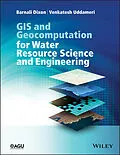Barnali Dixon is a Professor in the Department of Environmental Science, Policy and Geography at the University of South Florida St. Petersburg (USFSP) and the Director of the Geospatial Analytics Lab of USFSP.
Venkatesh Uddameri is a Professor in the Department of Civil, Environmental and Construction Engineering at Texas Tech University and the Director of the TTU Water Resources Center.
Autorentext
BARNALI DIXON is a Professor in the Department of Environmental Science, Policy and Geography, University of South Florida St. Petersburg (USFSP) and the Director of the Geospatial Analytics Lab of USFSP.
VENKATESH UDDAMERI is a Professor in the Department of Civil, Environmental and Construction Engineering at Texas Tech University and the Director of the TTU Water Resources Center.
Zusammenfassung
GIS and Geocomputation for Water Resource Science and Engineering not only provides a comprehensive introduction to the fundamentals of geographic information systems but also demonstrates how GIS and mathematical models can be integrated to develop spatial decision support systems to support water resources planning, management and engineering. The book uses a hands-on active learning approach to introduce fundamental concepts and numerous case-studies are provided to reinforce learning and demonstrate practical aspects. The benefits and challenges of using GIS in environmental and water resources fields are clearly tackled in this book, demonstrating how these technologies can be used to harness increasingly available digital data to develop spatially-oriented sustainable solutions. In addition to providing a strong grounding on fundamentals, the book also demonstrates how GIS can be combined with traditional physics-based and statistical models as well as information-theoretic tools like neural networks and fuzzy set theory.
Leseprobe
List of Acronyms
Abbreviation Details AAE Average absolute error ACRIMSAT Active Cavity Radiometer Irradiance Monitor Satellite ACWPP Arroyo Colorado Watershed Protection Program ADEQ Arkansas Department of Environmental Quality AF Attenuation factor AFC Attenuation factor calculator AFY Acre-feet per year AHP Analytical Hierarchy Process AI Artificial intelligence AIC Akaike's information criterion ANFIS Artificial Neuro-Fuzzy Information Systems ANN Artificial Neural Networks AOI Area of interest AP Apparent color ASCII American Standard Code for Information Interchange ASMC Antecedent soil moisture conditions ASR Aquifer storage and recovery ASTER Advanced Spaceborne Thermal Emission and Reflection Radiometer ASV Autonomous surface vehicles AVHRR Advanced Very High Resolution Radiometer AVIRIS Airborne Visible InfraRed Imaging Spectrometer AWRC Arkansas Water Resources Center BASINS Better Assessment Science Integrating Point and Nonpoint Sources BCF Billions of cubic feet BD Bulk density BGIS Basin Geomorphic Information System BIL Band interleaved by line BMPs Best Management Practices BOD Biochemical oxygen demand CAD Computer Aided Design CART Classification and regression trees CC Correlation coefficient CCN Certificate of convenience and necessity CEC Cation exchange capacity CERL Construction Engineering Research Laboratory CERP Comprehensive Everglades Restoration Plan CHIPS Colonia Health, Infrastructure, and Planning Status CI Convexity index CN Curve number COAV Class-object-attribute-value CSA Clay settling area CWA Clean Water Act DBMS Database management system DCIA Directly connected impervious area DEDNM Digital Elevation Drainage Network Model DEM Digital elevation model DFA Discriminant function analysis tab
Inhalt
Preface xiii
About the Companion Website xv
List of Acronyms xvii
Part I GIS, Geocomputation, and GIS Data 1
1 Introduction 3
1.1 What is geocomputation? 3
1.2 Geocomputation and water resources science and engineering 4
1.3 GIS-enabled geocomputation in water resources science and engineering 5
1.4 Why should water resources engineers and scientists study GIS 5
1.5 Motivation and organization of this book 6
1.6 Concluding remarks 7
References 9
2 A Brief History of GIS and Its Use in Water Resources Engineering 11
2.1 Introduction 11
2.2 Geographic Information Systems (GIS) - software and hardware 11
2.3 Remote sensing and global positioning systems and development of GIS 12
2.4 History of GIS in water resources applications 13
2.5 Recent trends in GIS 19
2.6 Benefits of using GIS in water resources engineering and science 20
2.7 Challenges and limitations of GIS-based approach to water resources engineering 20
2.8 Concluding remarks 23
References 25
3 Hydrologic Systems and Spatial Datasets 27
3.1 Introduction 27
3.2 Hydrological processes in a watershed 27
3.3 Fundamental spatial datasets for water resources planning: management and modeling studies 28
3.4 Sources of data for developing digital elevation models 30
3.5 Sensitivity of hydrologic models to DEM resolution 31
3.6 Accuracy issues surrounding land use land cover maps 32
3.7 Sensitivity of hydrologic models to LULC resolution 34
3.8 Sources of data for developing soil maps 36
3.9 Accuracy issues surrounding soil mapping 37
3.10 Sensitivity of hydrologic models to soils resolution 38
3.11 Concluding remarks 43
References 44
4 Water-Related Geospatial Datasets 47
4.1 Introduction 47
4.2 River basin, watershed, and subwatershed delineations 47
4.3 Streamflow and river stage data 48
4.4 Groundwater level data 48
4.5 Climate datasets 48
4.6 Vegetation indices 49
4.7 Soil moisture mapping 49
4.8 Water quality datasets 51
4.9 Monitoring strategies and needs 51
4.10 Sampling techniques and recent advancements in sensing technologies 52
4.11 Concluding remarks 53
References 53
5 Data Sources and Models 55
5.1 Digital data warehouses and repositories 55
5.2 Software for GIS and geocomputations 55
5.3 Software and data models for water resources applications 59
5.4 Concluding remarks 60
References 60
Part II Foundations of GIS 61
6 Data Models for GIS 63
6.1 Introduction 63
6.2 Data types, data entry, and data models 63
6.3 Categorization of spatial datasets 65
6.4 Database structure, storage, and organization 71
6.5 Data storage and encoding 75
6.6 Data conversion 76
6.7 Concluding remarks 78
References 80
7 Global Positioning Systems (GP…
